1997 PONTIAC GRAND AM brake
[x] Cancel search: brakePage 176 of 371
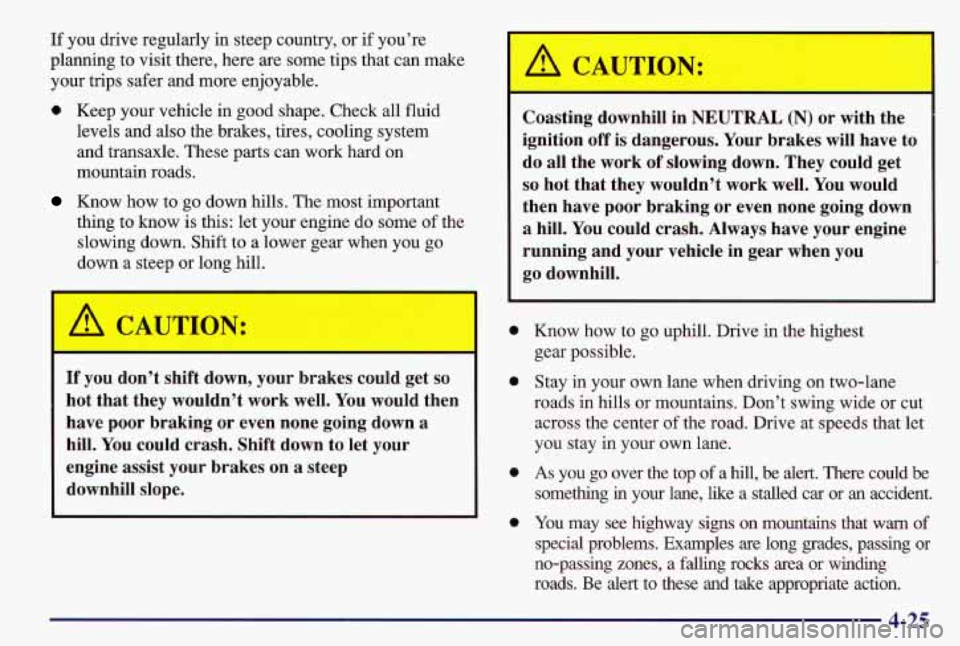
If you drive regularly in steep country, or if you’re
planning to visit there, here are some tips that can make
your trips safer and more enjoyable.
0 Keep your vehicle in good shape. Check all fluid
levels and also the brakes, tires, cooling system
and transaxle. These parts can work hard on
mountain roads.
Know how to go down hills. The most important
thing to know is this: let your engine do some
of the
slowing down. Shift to a lower gear when you go
down a steep or long hill.
~ A CAUTION:
I
If you don’t shift down, your brakes could get so
hot that they wouldn’t work well. You would then
have poor braking or even none going down
a
hill. You could crash. Shift down to let your
engine assist your brakes on
a steep
downhill slope.
A CAUTION:
Coasting downhill in NEUTRAL (N) or with the
ignition off is dangerous. Your brakes will have to
do all the work of slowing down. They could get
so hot that they wouldn’t work well. You would
then have poor braking or even none going down
a hill. You could crash. Always have your engine
running and your vehicle in gear when you
go downhill.
0
0
0
Know how to go uphill. Drive in the highest
gear possible.
Stay in your own lane when driving on two-lane
roads in hills
or mountains. Don’t swing wide or cut
across the center of the road. Drive at speeds that let
you stay in your own lane.
As you go over the top of a hill, be alert. There could be
something in your lane, like a stalled car
or an accident.
You may see highway signs on mountains that warn of special problems. Examples
are long grades, passing or
no-passing zones, a falling rocks area or winding
roads. Be alert to these
and take appropriate action.
4-25
Page 179 of 371
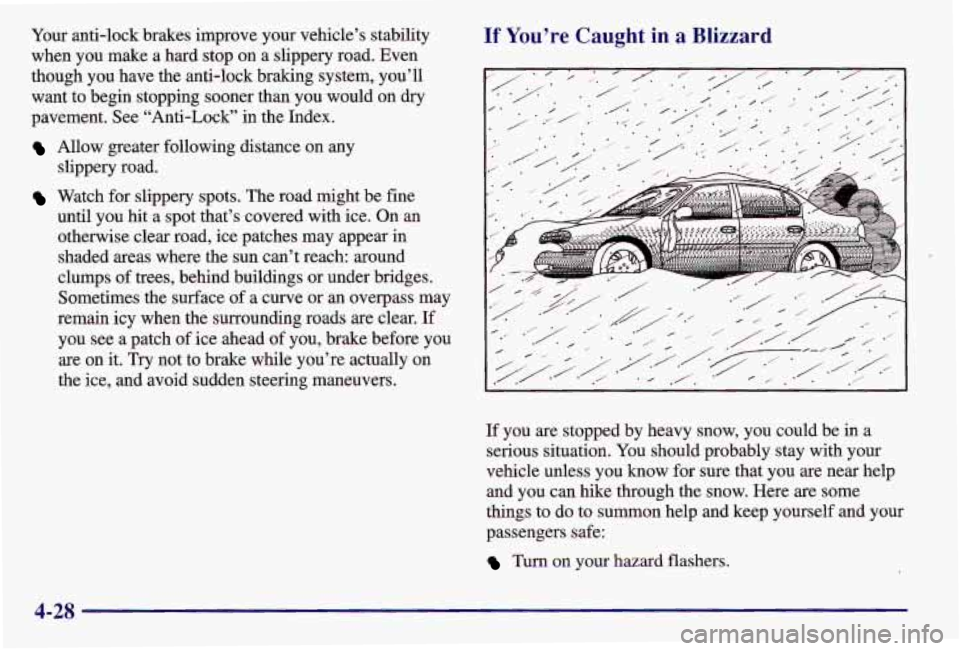
Your anti-lock brakes improve your vehicle’s stability
when you make a hard stop on a slippery road. Even
though you have the anti-lock braking system, you’ll
want to begin stopping sooner than you would on dry
pavement. See “Anti-Lock‘’ in the Index.
Allow greater following distance on any
slippery road.
Watch for slippery spots. The road might be fine
until you hit a spot that’s covered with ice.
On an
otherwise clear road, ice patches may appear in
shaded areas where the sun can’t reach: around
clumps of trees, behind buildings or under bridges.
Sometimes the surface of a curve or an overpass may
remain icy when the surrounding roads are clear.
If
you see a patch of ice ahead of you, brake before you
are on it.
Try not to brake while you’re actually on
the ice, and avoid sudden steering maneuvers.
If You’re Caught in a Blizzard
If you are stopped by heavy snow, you could be in a
serious situation. You should probably stay with your
vehicle unless you know for sure that you are near help
and you can hike through the snow. Here are some
things to do to summon help and keep yourself and your
passengers safe:
Turn on your hazard flashers.
4-28
Page 182 of 371

Follow these steps:
1. Put the front wheels on a dolly.
NOTICE:
Do not tow your vehicle with the front wheels in
contact with the
ground, or the automatic
transaxle could be damaged.
2.
3.
4.
5.
6.
Set the parking brake.
Open the fuse panel on the driver’s side of the
instrument panel. Remove the fuse labeled
PRNDL.
This will keep your battery from draining
while towing.
Turn the ignition key to
OFF to unlock the steering
wheel. See “Ignition Positions” in the Index.
Clamp the steering wheel
in a straight-ahead position,
with a clamping device designed for towing.
Release the parking brake.
Towing Your Vehicle from the Front
(Manual Transaxle Only)
If your vehicle has a manual transaxle, you may tow
your vehicle with all four wheels on the ground.
4-31
Page 183 of 371
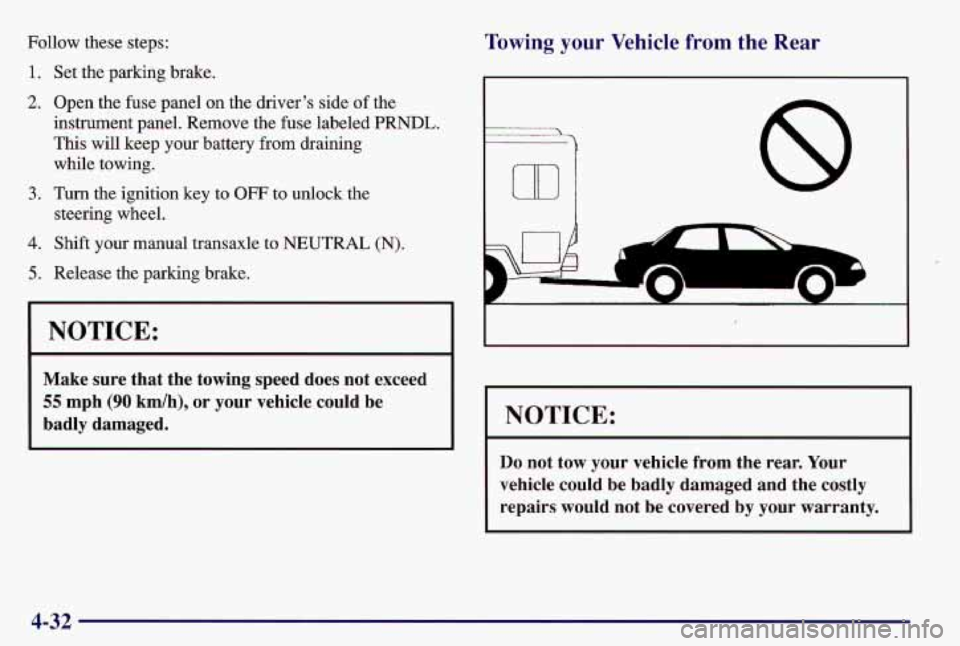
Follow these steps:
1.
2.
3.
4.
5.
Set the parking brake.
Open the fuse panel on the driver's side
of the
instrument panel. Remove the fuse labeled PRNDL.
This will keep your battery from draining
while towing.
Turn the ignition key to
OFF to unlock the
steering wheel.
Shift your manual transaxle to NEUTRAL (N).
Release the parking brake.
I NOTICE:
Make sure that the towing speed does not exceed
55 mph (90 km/h), or your vehicle could be
badly damaged.
Towing your Vehicle from the Rear
cID 8
n
NOTICE:
Do not tow your vehicle from the rear. Your
vehicle could be badly damaged'and the costly
repairs would not be covered by your warranty.
4-32
Page 186 of 371
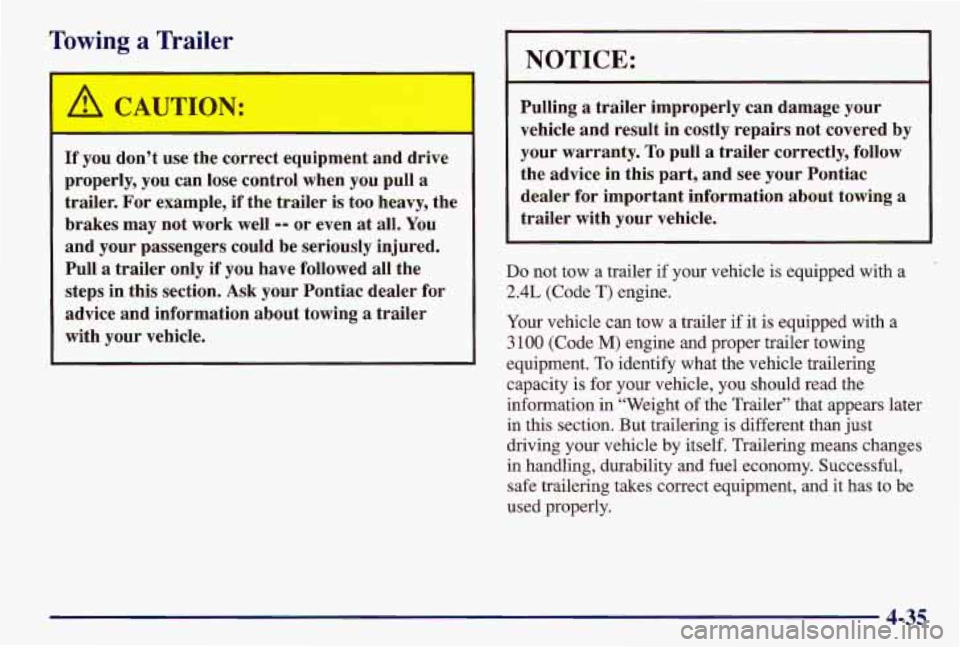
Towing a Trailer
If you don’t use the correct equipment and drive
properly, you can lose control when you pull
a
trailer. For example, if the trailer is too heavy, the
brakes may not work well
-- or even at all. You
and your passengers could be seriously injured.
Pull
a trailer only if you have followed all the
steps in this section. Ask your Pontiac dealer for
advice and information about towing
a trailer
with your vehicle.
NOTICE:
Pulling a trailer improperly can damage your
vehicle and result in costly repairs not covered by
your warranty.
To pull a trailer correctly, follow
the advice in
this part, and see your Pontiac
dealer for important information about towing
a
trailer with your vehicle.
Do not tow a trailer if your vehicle is equipped with a
2.4L (Code T) engine.
Your vehicle can tow a trailer if
it is equipped with a
3 100 (Code M) engine and proper trailer towing
equipment.
To identify what the vehicle trailering
capacity
is for your vehicle, you should read the
information in “Weight
of the Trailer’’ that appears later
in this section. But trailering is different than just
driving your vehicle
by itself. Trailering means changes
in handling, durability and fuel economy. Successful,
safe trailering takes correct equipment, and it has to be
used properly.
4-35
Page 189 of 371
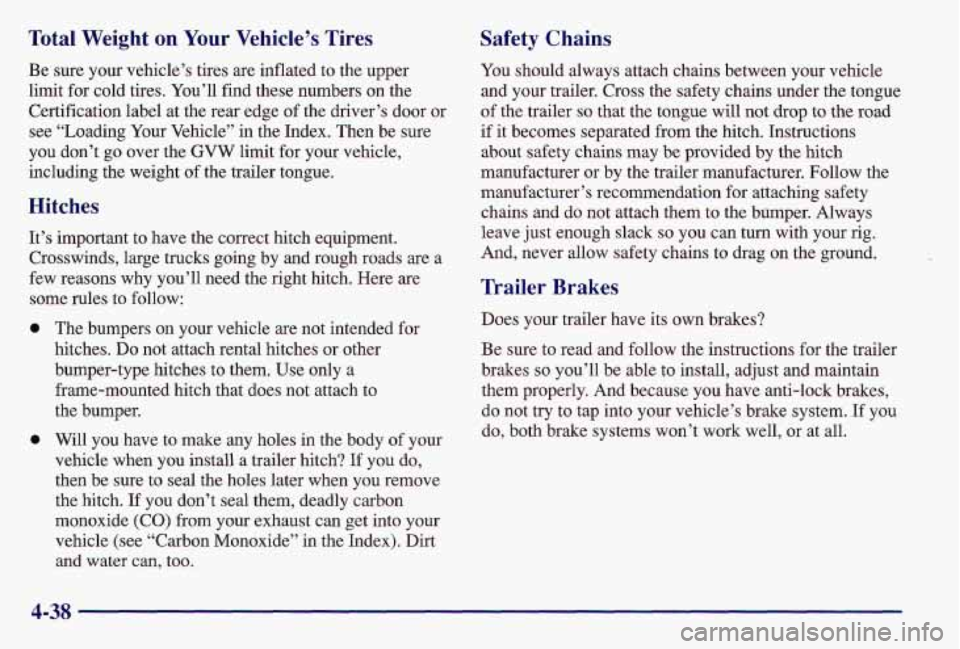
Total Weight on Your Vehicle’s Tires
Be sure your vehicle’s tires are inflated to the upper
limit for cold tires. You’ll find these numbers
on the
Certification label at the rear edge of the driver’s door or
see “Loading Your Vehicle” in the Index. Then be sure
you don’t go over the
GVW limit for your vehicle,
including the weight
of the trailer tongue.
Hitches
It’s important to have the correct hitch equipment.
Crosswinds, large trucks going by and rough roads are a
few reasons why you’ll need the right hitch. Here are some rules to follow:
0 The bumpers on your vehicle are not intended for
hitches.
Do not attach rental hitches or other
bumper-type hitches to them. Use only a frame-mounted hitch that does not attach to
the bumper.
Will you have to make any holes
in the body of your
vehicle when you install a trailer hitch?
If you do,
then be sure to seal the holes later when you remove
the hitch.
If you don’t seal them, deadly carbon
monoxide (CO) from your exhaust can get into your vehicle (see “Carbon Monoxide” in the Index). Dirt
and water can, too.
Safety Chains
You should always attach chains between your vehicle
and your trailer. Cross the safety chains under the tongue
of the trailer
so that the tongue will not drop to the road
if it becomes separated from the hitch. Instructions
about safety chains may be provided by the hitch
manufacturer or by the trailer manufacturer, Follow the
manufacturer’s recommendation for attaching safety
chains and do not attach them to the bumper. Always
leave just enough slack
so you can turn with your rig.
And, never allow safety chains to drag on the ground.
Trailer Brakes
Does your trailer have its own brakes?
Be sure to read and follow the instructions for the trailer
brakes
so you’ll be able to install, adjust and maintain
them properly. And because you have anti-lock brakes,
do not try to tap into your vehicle’s brake system. If you
do, both brake systems won’t work well, or at all.
4-38
Page 190 of 371
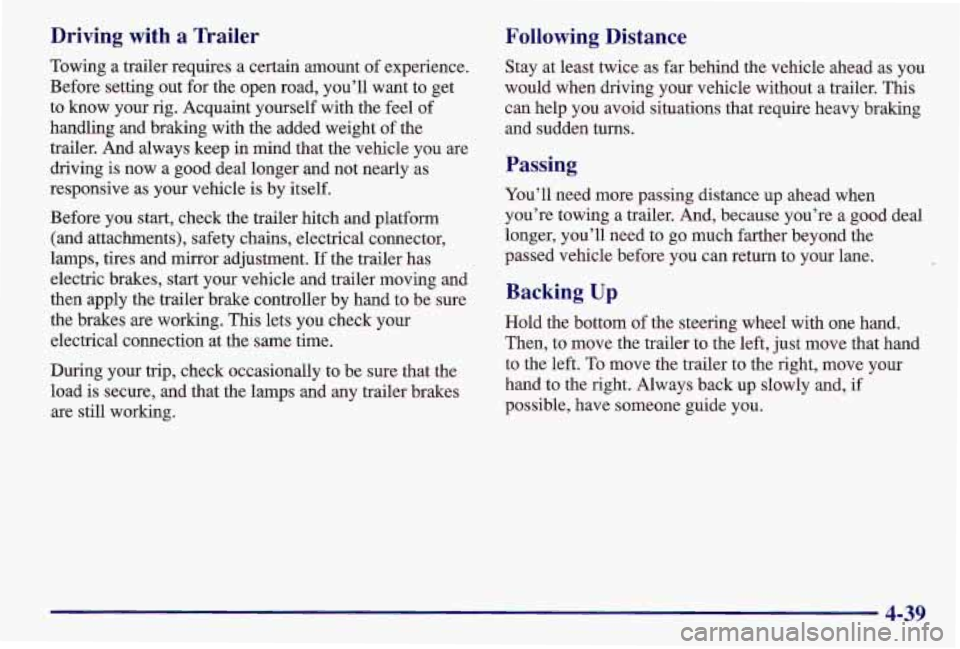
Driving with a Trailer
Towing a trailer requires a certain amount of experience.
Before setting out for the open road, you’ll want to get
to know your rig. Acquaint yourself with the feel of
handling and braking with the added weight of the
trailer. And always keep in mind that the vehicle you are
driving is now a good deal longer and not nearly as
responsive as your vehicle is by itself.
Before you start, check the trailer hitch and platform
(and attachments), safety chains, electrical connector,
lamps, tires and mirror adjustment. If the trailer has
electric brakes, start your vehicle and trailer moving and
then apply the trailer brake controller by hand to be sure
the brakes are working. This lets you check your
electrical connection at the same time.
During your trip, check occasionally to be sure that the load is secure, and that the lamps and any trailer brakes
are still working.
Following Distance
Stay at least twice as far behind the vehicle ahead as you
would when driving your vehicle without a trailer. This
can help you avoid situations that require heavy braking
and sudden turns.
Passing
You’ll need more passing distance up ahead when
you’re towing a trailer. And, because you’re a good deal
longer, you’ll need to go much farther beyond the
passed vehicle before you can return to your lane.
Backing Up
Hold the bottom of the steering wheel with one hand.
Then, to move the trailer to the left, just move that hand
to the left. To move the trailer to the right, move your
hand to the right. Always back up slowly and, if
possible, have someone guide you.
4-39
Page 191 of 371
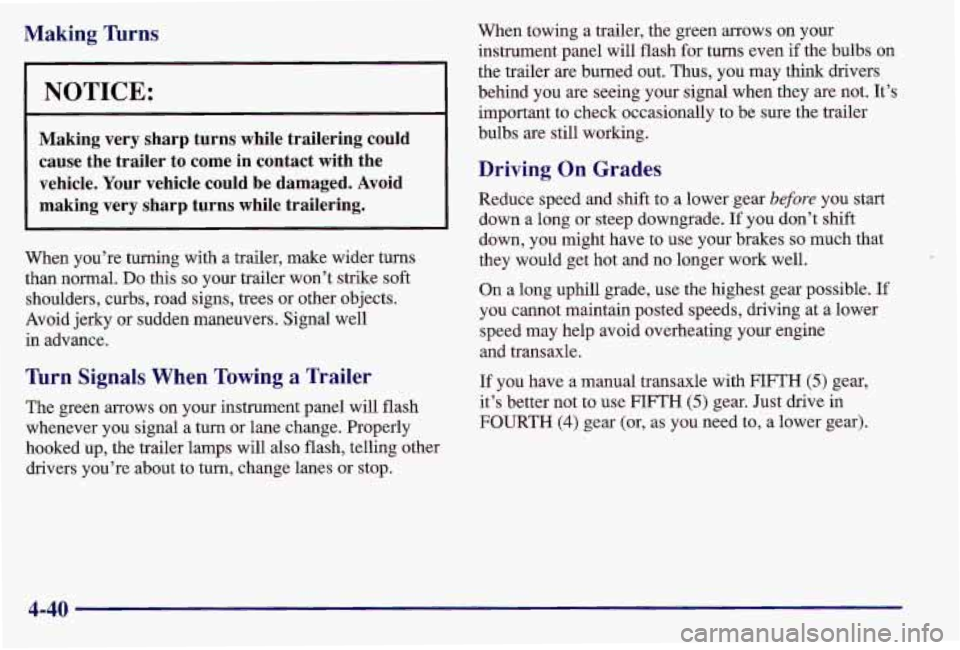
Making Turns
I NOTICE: 1
Making very sharp turns while trailering could cause the trailer to come in contact with the vehicle. Your vehicle could be damaged. Avoid
making very sharp turns while trailering.
1
When you’re turning with a trailer, make wider turns
than normal.
Do this so your trailer won’t strike soft
shoulders, curbs, road signs, trees or other objects.
Avoid jerky or sudden maneuvers. Signal well
in advance.
Turn Signals When Towing a Trailer
The green arrows on your instrument panel will flash
whenever you signal a turn or lane change. Properly
hooked up, the trailer lamps will also flash, telling other
drivers you’re about to turn, change lanes
or stop. When
towing a trailer, the green arrows on your
instrument panel will flash for turns even
if the bulbs on
the trailer are burned out. Thus, you may think drivers
behind you are seeing your signal when they are not. It’s
important
to check occasionally to be sure the trailer
bulbs are still working.
Driving On Grades
Reduce speed and shift to a lower gear before you start
down a long or steep downgrade.
If you don’t shift
down, you might have to use your brakes
so much that
they would get hot and no longer work well.
On a long uphill grade, use the highest gear possible. If
you cannot maintain posted speeds, driving at a lower
speed may help avoid overheating your engine
and transaxle.
If you have a manual transaxle with FIFTH
(5) gear,
it’s better not to use FIFTH
(5) gear. Just drive in
FOURTH
(4) gear (or, as you need to, a lower gear).
4-40